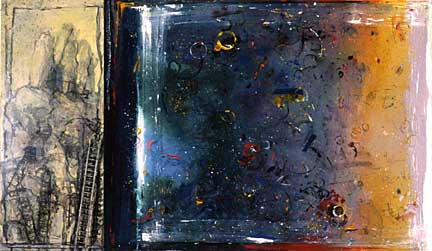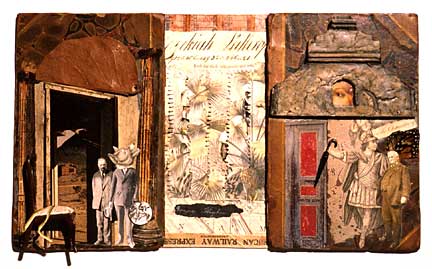 |
James Del Grosso
Napeague Cherries - 1995
oil on canvas
16 x 24 inches (40.64 x 60.96 cm)
James Del Grosso I begin work by arranging some objects, such as an apple and some grapes, by a window with natural light. I prefer a single light source because it shows the most weight of objects and creates the most dramatic effects. Simplicity of both objects and composition is important to keep the viewers within themselves. I don't want them disturbed by ambiguity, complicated arrangements, or unfamiliar objects. I want the form and the light to be the unquestioned subjects. I use a camera to help me see objectively and to record close-up details. Looking through the lens separates me from what I'm looking at and helps me to see what's there rather than what I think is there. I take many rolls of film of each arrangement and many arrangements of the same objects before I find one I'll work into a painting. I work quickly on a painting, and within a few days, I have it looking almost finished, to other people, but at this point it's only the beginning of many more hours of slowly clarifying the images. I work with thin washes or glazes of color, adding one upon the other to achieve the effects I want. This process takes time and helps me to think slowly. I strive to give a clear and large-scale experience of simply seeing. James Del Grosso, October 2000 Painter's a Master With Light Begin with a thoroughly modern sensibility - an exquisite sense of form and composition enlivened by a dash of drama. Bathe those forms in a cool, defining light that harks back to the American luminists. And, finally, complete the whole with a painstaking old master's polish. What do you have? James Del Grosso's still-life paintings. Light still is the predominant element in his work - a light that reveals the solidity of his forms and the clarity of his painstaking application of glaze upon glaze. But there is a new drama in his use of light and the monumentality of the mundane objects of the domestic still life. Del Grosso wants us to see - to see clearly, emphatically and specifically. Through scale (imagine a 3-by-5-foot painting of grapes) and light, Del Grosso forces viewers to abandon what we assume or know about a thing and to see each object anew. Much larger-than-life stainless steel kitchen implements are revealed as objects of intriguing and complex shapes with a surface sheen that is spectacular. A single onion becomes a celebration of graceful form and exquisite textures. So much art today is surrounded by a veil of ideas or used to promulgate social or political positions that it is especially refreshing when an artist like Del Grosso offers us the opportunity to indulge in the simple pleasures of seeing. Excerpt from CeCe Bullard Richmond Times, July 1994 James Del Grosso
 |
Tino
Zago
Tre Cime di Lavaredo #6 - 1999
mixed media on canvas
46 x 78 inches (117 x 198 cm)
Tino Zago Tino Zago's new series of paintings, Tre Cime di Lavaredo, was inspired by a famous mountain peak in the Dolomite Alps of Italy near where Tino was born. Tre Cime, with it vibrant hues of pinks and mauves, is a mountain range that is well known to hikers and mountain climbers. Tino was born in Crespano del Grappa, a small town north of Venice, and has lived in the United States since 1948. He spent his formative years in the Detroit area and received his MFA degree in painting from Cranbrook Academy of Art in Michigan in 1965. He went on to attended Yale University where he studied painting under Lester Johnson. Tino has exhibited extensively in solo and group exhibitions in New York and internationally. (Tino Zago) knows light as it hits land, water, vegetation and clouds. He knows color in different places and different seasons. He inventively composes it all with various perspectives so the cool, blue water in Nova Scotia is looked down on from the rocky coast of the Dolomites in Italy. Most of all he knows paint and how to make a scribble of brush strokes feel like a ripple of water or water plants, how to make other applications feel like rock or drips seem like falling stars. With paint, he makes long-term, deeply felt, poetically observed magic. He is a gentle man, and that comes through in the sensitivity of his work. He uses acrylics and paints quickly on canvases spread on the floor, finishing in a few days. He builds wet paint on top of wet paint, a technique that helps give his works fluidity. And he doesn't go back into the paintings; it's how he achieves that important sense of the moment, of chance occurrences, and that makes the paintings fresh. He's fighting time and the paint, pressures that give the paintings an intensity. And if a painting doesn't work when he stands it against the wall, he throws it out. "Just about everything is keyed to nature," Zago says. "I felt the need to do these paintings of nature when I was in my studio on the Bowery, because I am inventing my feelings of other places and times. I love the inventiveness and surprises." Excerpt from Marsha Miro Detroit Free Press, October, 1990 Tino Zago
 |
John Kiki
Man with Striped Trousers (after Manet) - 2000
acrylic on canvas
72 x 66 inches (182.88 x 167.64 cm)
John Kiki I did the work in this show with this exhibition in mind. I wanted to put all my past experiences, subjects and characters together. I used an element of mythology and surrealism using the "Hat" (influenced by my ethnic neighborhood) as an extension of the Head both as a unifying element for the whole show, and as a starting point for the next painting. When the subject was established, the challenge then was to make the image believable and not preconceived. Nothing I put on the canvas was safe, a painting that started off as "The Bullfight" would become "Figures in a Landscape with Centaurs" and the painting which I planned to make after "Manet's Olympia" became "The New Yorkers". A part of a painting that I thought was special sometimes had to be sacrificed so the way forward could continue. The subject was only a starting point: Thereafter, intuition? Accident? The subconscious? took over. This is when something of interest happened for me, which is altogether new to my repertoire. John Kiki, October 2000
 |
Gail
Raab
Going Higher - 2000
mixed media
16.75 x 22.75 inches (42.55 x 57.78 cm)
Gail Raab Open Book Series My new works of collage reflect a love of the past and a fascination I have always had with the discarded and found objects of everyday life; rusted keys, feathers from old hats, faded maps and photographs, letters long forgotten, aged marbleized book covers. I have always loved books, the feel of their bindings as well as their contents waiting to be deciphered, their visions to be unveiled. My work attempts to provide an illustrative illusion of content communicating with the viewer an image which spans the conceptual space between the printed word and the cerebral image. The book covers become the walls housing my visual language, illustrating a story forever changing, depending on the interpretation of the viewer. The covers I use served utilitarian functions in their original purpose. In discarding their literary contexts I disclose previously hidden contexts opening new secrets to dissect, new relationship to ponder, presenting an infinite range of previously hidden possibilities. Architectural elements have been incorporated adding texture and dimension to the work. I have been a passionate collector of found objects for many years foraging on city streets, in flea markets, antique shops and yard sales, to unearth the unexpected and the ambiguous. They fill baskets and drawers in my studio, awaiting the moment in which they form a new union. Will these objects remain intact and in context for the years to come. Have we successfully saved them from the instability of their original function and placed them in a context of meaning where they will now be successfully embalmed to perplex the imaginations of future observers. For this is my purpose, to make of the viewer an active participant in the creation of an ever changing work of art. A storyteller of form and object to challenge the readers contemplation of these hieroglyphics of the past. These normatively incompatible artifacts and souvenirs are juxtaposed with figurative images, creating tension in their seemingly random contrast, while attempting to create an overriding harmony in their composition. The collages become a recreated, intimate world of treasured images, making time stand still and giving society's discards a new context and continued life. I think of my work as mystical and magical, with the promise of complex imagery one hopefully will continue to explore. Gail Raab, October 2000
 |
YounJoo
Ham
A Smooth Tension - 2000
springs on wood panel
11 x 11 inches (27.94 x 27.94 cm)
YounJoo Ham I have worked with the concept of "tension". Tensility has provided the basis for my interaction with different materials. The visualization of tension is expressed in their interactions. The essence of my work is to illustrate the materials' inherent energies through the repetition of delicate and careful tasks in handling. With each step of my process, I am constructing my own language. When a task is repeated exhaustively, the result of the process creates a temporal record into the viewer's experience. Most of my work is created from a personal instinct to seek the ultimate form of beauty in sculpture. In this pursuit I have found a personal way of interacting with materials in order to establish an understanding of my surroundings based on my life's experiences. During the process, tension is introduced and developed into an artistic activity. It is visualized into a calm state. The stronger the tension, the more stable and placid is its effect. When I reach the most extended and durable limit of tension, I have attained the ideal of beauty. The finished sculptures are the visual representation of my engagement with this process. YounJoo Ham, October 2000
This web site was designed and created by REDRUM DESIGNS ©2000 OK HARRIS All Rights Reserved